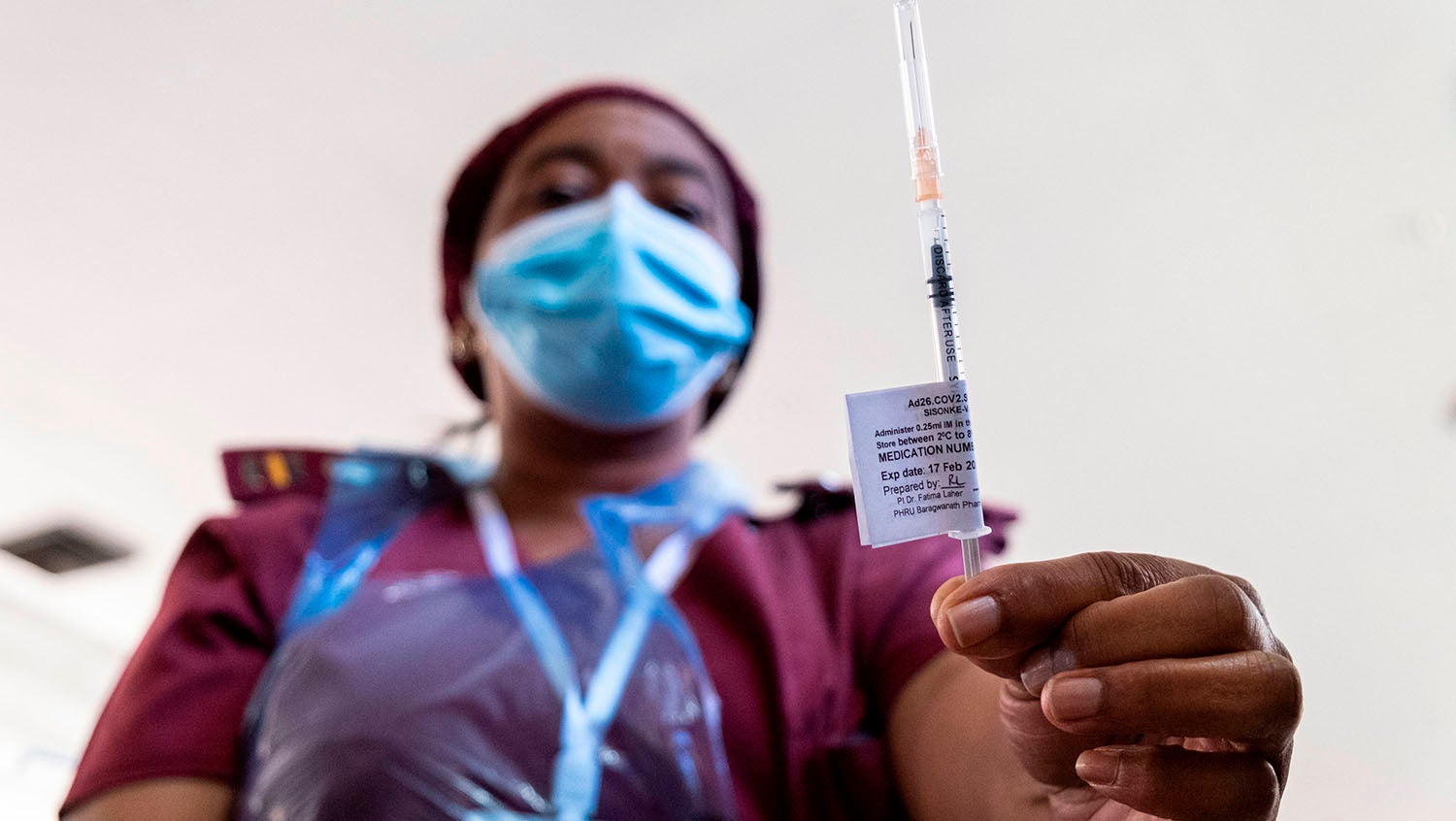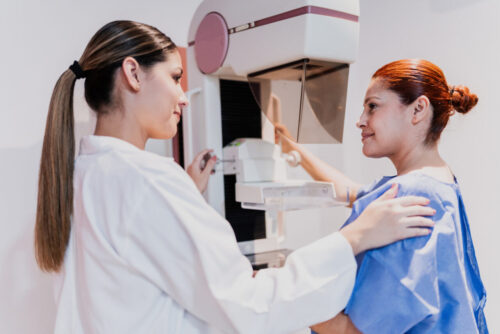The Johnson & Johnson Vaccine's Differences Are Pros, Not Cons
March 1, 2021

Emmanuel Croset, Getty Images
With a single dose, less strict storage requirements, and high efficacy against death and hospitalization, the new COVID-19 vaccine could help fill gaps in access.
The United States just reached a terrible milestone: 500,000 Americans have died due to COVID-19. Since August 2020, there have been nearly 1.8 million people hospitalized with confirmed COVID-19 in the U.S. Now, as of Saturday, February 27, we have another product that will allow us to accelerate the rollout of COVID-19 vaccinations, the FDA-approved Johnson & Johnson vaccine. But it’s not just that another approved vaccine will increase the sheer number of doses, which is important to expedite the rollout, but it’s also how hospitals, health centers, and other organizations can think about using the Johnson & Johnson vaccine in ways they may not be able to use ones from Pfizer-BioNTech and Moderna.
All three COVID-19 vaccines are similar in the ways that count: complete prevention of hospitalization and death related to SARS-CoV-2. Early news about the Johnson & Johnson vaccine’s efficacy rates highlighted effectiveness against COVID-19 infection overall, which seemingly lead to concerns about obtaining that vaccine. However, it’s crucial that we reframe what all of the data tells us.
What’s being highlighted is that, while Pfizer-BioNTech and Moderna are both approximately 95% effective in preventing symptomatic COVID-19 infection, Johnson & Johnson’s vaccine is 72% effective in the U.S. and 66% effective overall. Keeping in mind that 72% is still vastly higher than the 50% Dr. Anthony Fauci indicated would make an effective vaccine in reducing rate of transmission helpful to get our society back, that’s still looking at data in the reverse order. Instead of protection against infection overall, what we should be highlighting is the efficacy against what we’re most trying to avoid: loss of life and severe illness.
The good news is that the Johnson & Johnson vaccine does seem to prevent, after 28 days, 100% of hospitalizations and deaths from COVID-19.
Johnson & Johnson vaccine differences affect access and hesitancy
While the efficacy against hospitalization and death related to COVID-19 is similar among all three vaccines, it’s true that Johnson & Johnson COVID-19 vaccine is different in other ways. It has a different mechanism, a different dose schedule, different doses, and different refrigeration and storage.
Unlike the Moderna and Pfizer-BioNTech vaccines, Johnson & Johnson’s vaccine doesn’t use mRNA technology. Instead, it uses a “Trojan horse approach.” It contains a hollowed-out virus, the adenovirus vector, that delivers a DNA code. Our bodies read the DNA code and create a protein similar to the spike protein of SARS-CoV-2, which is recognized as a foreign invader by the body. That recognition prompts the recruitment of our body’s immune system and development of antibodies. These will protect us from COVID-19 infection, and the hollowed-out virus cannot replicate and cannot cause infection.
This type of vaccine is one that has been tested and studied over a longer period of time than mRNA vaccines. It’s one we’ve seen before. It’s been available for Ebola, for example, with a great track record. It’s possible that the known quantity of this type of vaccine could help overcome hesitancy we see about getting an mRNA vaccine, but that remains to be seen.
Another difference with the Johnson & Johnson vaccine is that it was tested in both Brazil and South Africa at a time when the respective Brazil and South Africa variants were circulating as their dominant COVID-19 virus. During that time, the vaccine was more than 80% effective against severe disease in both countries after 28 days. That’s really good news because we don’t have that kind of data yet with Moderna or Pfizer-BioNTech — they were tested at a time when we didn’t have these variants.
Two game-changing differences with the Johnson & Johnson vaccine in terms of rollout and access are that it’s a single dose, as opposed to two, and it has less strict refrigeration requirements.
One dose and different storage requirement mean that it can be more easily available to people and areas that would otherwise be difficult to vaccinate: very rural areas, populations that have difficulties with mobility, people experiencing homelessness, communities of color with lack of transportation, and others. Hospitals could also more easily leverage emergency department visits, for example, as vaccination points of access. Whether it’s single-dose appointments or mobile vaccination plans for equity purposes, Johnson & Johnson’s vaccine would fit well into those approaches.
Rethinking the “inferior vaccine” perception
What’s crucial, however, is developing messaging for those distributing the vaccine. We must be clear and transparent about the data and the safety to the communities who may benefit from the single-dose vaccine option. We must not give the message that we are consigning populations who experience homelessness, those with substance use disorder, communities of color with limited transportation and seniors with lower mobility, etc., to an “inferior” vaccine with a lower overall efficacy rate. We must point to the efficacy against hospitalization and death, and specifically to how the vaccine performed in the elderly, in women, in communities of color — the relevant populations.
By just centering the “72% vs. 95% efficacy” stat, the Johnson & Johnson vaccine appears inferior and people start to make value judgments among the vaccines available. There’s a danger of these vaccines being branded as lifestyle products, with people picking a brand to align with. We must caution against this mindset.
Right now, it’s a race against time. We see the destruction that is left in the pandemic’s wake in terms of hospitalizations, severe illness, loss of work, long-term disability, and sickness among many people who were previously young and healthy. This is something to be avoided at all costs. I would encourage people to take whichever vaccine is offered, when they are eligible and it is available.
The “best” vaccine is the one you have been offered.
The Johnson & Johnson vaccine and global equity
Additional approved vaccines in general could mean we’ll amass sufficient doses that will help to address vaccine-access disparities in structurally vulnerable populations — both in the U.S. and across the globe. Globally, there are approximately 130 countries that have delivered zero doses of COVID-19 vaccines. Hopefully, having more vaccines available overall will decrease the amount of vaccine hoarding that is happening in higher-income countries.
The Johnson & Johnson vaccine, with its single dose and less strict storage and transport requirements, can benefit higher risk populations across the globe.
If we focus only on vaccinating our own population — and only on countries that have the wherewithal to leverage prepayments — it’s not going to help when the next COVID variant develops and decimates all of that vaccination work. We in the U.S. will be further behind because, not only will be have hotspots of variance in people who may have been previously vaccinated, but people may also be demoralized and potentially less willing to participate in the next cycle of vaccination. So, it’s crucial that we think about delivering vaccines on a global scale, not just an American scale.
That’s why equity should appeal to us. Because we don’t get it right, then it’s just going to come back to bite us.


